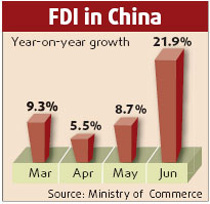Economic growth remains rapid and the trade surplus continues to widen, while the pattern of growth remains unchanged, notes the World Bank's China Quarterly Update released today.
The rising trade surplus, which so far seems little affected by measures to contain export growth, constitutes the bulk of the rising balance of payment surplus. This surplus, together with financial sector developments, is adding to domestic liquidity and contributing to asset price rises, share prices in particular. Although consumer price inflation has risen to a decade high, this has largely been because of higher food prices.
The Quarterly Update finds that the recent international financial market turmoil may affect China's economy, but that China is well-placed to absorb the impact. Although the direct financial impact seems to be limited, China would be affected by an economic slowdown in key markets, because of the large weight of exports in China's economy.
But China is in a strong position. "China is well-placed to deal with the possible impact of slower global growth," says Louis Kuijs, senior economist for China and the main author of the report. "A moderate global slowdown would actually mitigate concerns of policymakers on overall growth, inflation, and the trade surplus, while China's strong macroeconomic position provides room to adjust the domestic policy stance if necessary."
China's macroeconomic prospects remain good, concludes the Quarterly Update. Internationally, there are no indications that cost pressures are reducing the competitiveness of China's exports. Domestically, prospects remain buoyant. Profit and credit growth are high, so investment is likely to continue to expand strongly. Consumption is expected to remain solid, although higher inflation is constraining real consumption growth.
The World Bank now projects GDP growth of 11.3 percent in 2007 and below 11 percent in 2008. International food prices are expected to increase further, but industrial commodity and producer price rises may continue to moderate. The World Bank expects CPI inflation to gradually ease from later in 2007 onwards, but thinks there are upward risks. The Bank now projects a current account surplus of around 12 percent of GDP in 2007.
The external imbalance remains the main macroeconomic policy issue. While there are no serious demand and price pressures yet, the very strong growth risks eventually outpacing supply. Thus, the authorities are rightly aiming at avoiding excess demand and the spillover of high food prices into generalized inflation, and mopping up liquidity and raising interest rates will continue to be needed.
"However, the main macroeconomic task remains to contain the trade surplus, and a stronger real exchange rate is the most obvious tool," says Bert Hofman, lead economist for China. "Reducing the external imbalance may become an important contribution from China to world growth, if a sharper than expected US slowdown were to affect this adversely." The government has taken some tax-based measures to contain the surplus. However, more policy action is likely to be needed.
A key challenge remains to rebalance the economy. This calls for further fiscal and structural policy measures, which are discussed in the Quarterly Update.
In a special section, the Quarterly Update addresses the issue of whether China is running the risk of labor shortage. The section concludes that, while continued rapid growth would eventually exhaust China's surplus labor, this is unlikely to happen soon. Next to demographics, policies also affect labor supply. The section discusses the impact of policies, in particular those on education, pensions, land reform, and migration.
(China.org.cn September 12, 2007)


